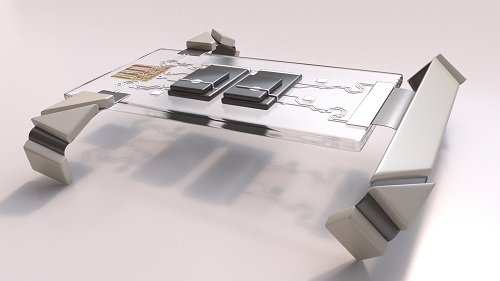
Lasers Allow Mass-Producible Microscopic Robots to Walk
A collaboration led by Cornell University has created mass-producible microscopic robots with semiconductor components that allow them to be controlled and made to walk with laser light and standard electronic signals.
The robots are roughly the size of a paramecium and provide a template for building even more complex versions that use silicon-based intelligence, that can be mass-produced, and that may someday travel through human tissue and blood.
The project, led by Itai Cohen and Paul McEuen of Cornell and their former postdoctoral researcher Marc Miskin, now an assistant professor at the University of Pennsylvania, yielded robots about 5 µm thick, 40 µm wide, and 40 to 70 µm in length. Each robot consists of a simple circuit made from silicon photovoltaics — which essentially function as both the torso and brain — and four electrochemical actuators that function as legs.

A microscopic robot capable of being controlled by shining a laser on its photovoltaic components. Courtesy of Cornell University.
“This research breakthrough provides exciting scientific opportunity for investigating new questions relevant to the physics of active matter and may ultimately lead to futuristic robotic materials,” said Sam Stanton, program manager for the Army Research Office of the Combat Capabilities Development Command’s Army Research Laboratory, which supported the research.
The researchers control the robots by flashing laser pulses at different photovoltaics, each of which charges up a separate set of legs. By toggling the laser back and forth between the front and back photovoltaics, the robot walks.
The robots are made through standard lithographic processes and can be fabricated in parallel. About 1 million fit on a 4-in. silicon wafer. They operate with low voltage, 200 mV, and low power, 10 nW, and are fairly strong for their size.
“Controlling a tiny robot is maybe as close as you can come to shrinking yourself down. I think machines like these are going to take us into all kinds of amazing worlds that are too small to see,” Miskin said.
The researchers are now exploring ways to beef up the robots with more complex electronics and onboard computation. Those improvements could one day enable swarms of microscopic robots capable of restructuring materials, suturing blood vessels, or being deployed en masse to probe swathes of the human brain.
The research was published in Nature (www.doi.org/10.1038/s41586-020-2626-9).
Published: September 2020